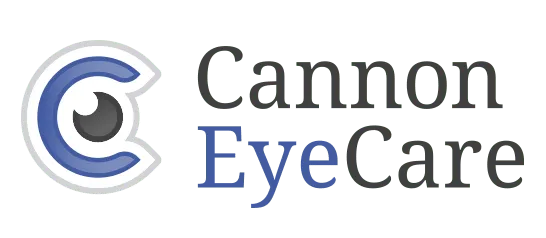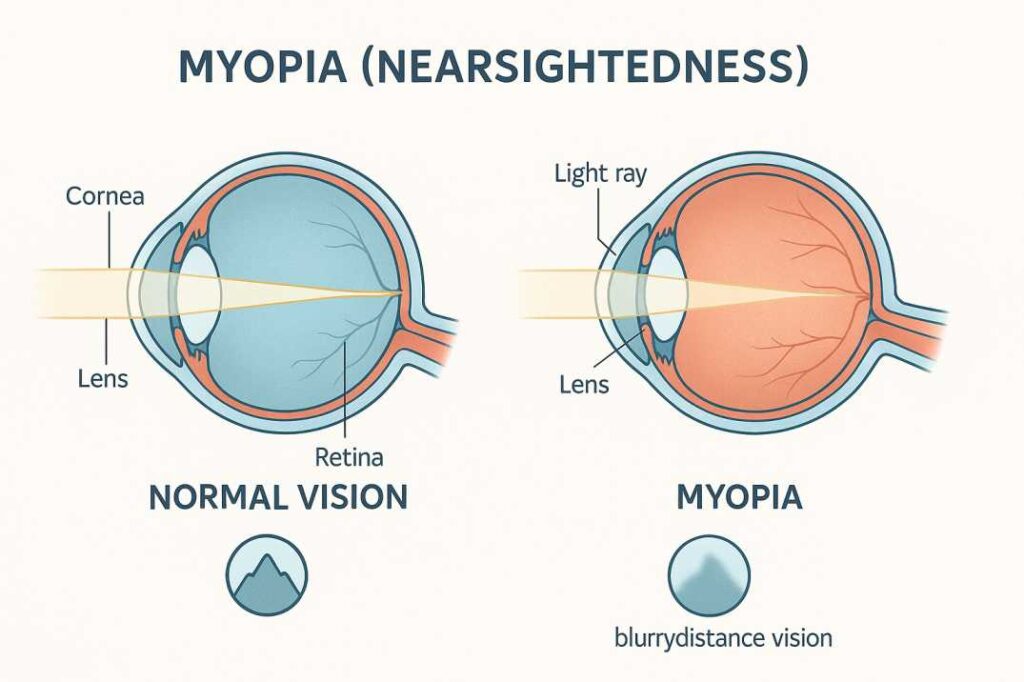Myopia
Managing myopia requires expert care and personalized treatment approaches. If you’re experiencing vision changes or have concerns about myopia progression, comprehensive eye care can make a significant difference in protecting your long-term vision health. At Cannon EyeCare in Seattle’s University Village and Pike Place Market locations, we combine evidence-based treatments with personalized care to safeguard your vision for the future.
Understanding Myopia: Expert Care for Your Vision
Myopia, commonly referred to as nearsightedness, has emerged as one of the most significant eye health challenges of the 21st century. This evidence-based guide provides comprehensive information about myopia, examining its causes, symptoms, and the most current treatment advances available in 2025. At Cannon EyeCare, our commitment extends beyond basic vision correction to encompass comprehensive, personalized care designed to protect your long-term ocular health.
What is Myopia?
Myopia is a refractive error characterized by clear near vision while distant objects appear blurred. This condition develops when the eyeball grows disproportionately long or when the cornea exhibits excessive curvature, resulting in light focusing anterior to the retina rather than directly upon it.
According to the clinical definition, myopia represents “a refractive error in which rays of light entering the eye parallel to the optic axis are brought to a focus in front of the retina when ocular accommodation is relaxed. This usually results from the eyeball being too long from front to back, but can be caused by an overly curved cornea and/or a lens with increased optical power.”
The Global Myopia Epidemic: Statistical Overview
Contemporary epidemiological data reveal alarming trends in myopia prevalence worldwide. Current projections indicate that approximately 49.8% of the global population—nearly 4.8 billion individuals—will develop myopia by 2050. Present estimates suggest that roughly 30% of the world’s population currently experiences some degree of myopia.
Within the United States specifically, myopia prevalence has demonstrated a dramatic increase, nearly doubling from approximately 25% in the early 1970s to over 40% by 2004, with continued upward trends observed particularly among younger demographics.
Recent research published in the Journal of the American Medical Association (JAMA) Network reinforces these projections, stating that “by 2050, nearly one-half of the world’s population will have myopia.” This unprecedented increase has prompted healthcare professionals and researchers to characterize the situation as a “myopia epidemic,” necessitating immediate and comprehensive public health interventions.
Clinical Presentation: Recognizing Myopia Symptoms
Early identification of myopia symptoms proves crucial for timely intervention and optimal treatment outcomes. Healthcare providers and patients should remain vigilant for the following clinical manifestations:
Vision-Related Symptoms:
- Blurry vision when looking at distant objects
- Clear vision for close-up tasks like reading
- Difficulty seeing road signs, chalkboards, or movie screens
- Squinting to see distant objects clearly
Physical Symptoms:
- Eye strain and fatigue
- Headaches, especially after activities requiring distance vision
- Tiredness when driving or playing sports
- Difficulty seeing at night
Behavioral Signs in Children:
- Sitting close to the television
- Holding books or devices very close to their face
- Poor performance in school or sports
- Shortened attention span during distance-vision activities
- Complaints about not being able to see the board at school
Etiology and Risk Factor Analysis
The development of myopia involves a multifactorial interplay between hereditary predisposition and environmental influences. Contemporary research has significantly advanced our understanding of these contributing factors.
Hereditary Predisposition
Extensive familial studies demonstrate a clear genetic component in myopia development. Children with two myopic parents exhibit significantly elevated risk profiles compared to those with non-myopic parents. Recent meta-analyses examining global myopia prevalence patterns indicate that myopia risk increases threefold in children whose parents have the condition.
Despite this genetic influence, hereditary factors alone cannot account for the rapid escalation in myopia prevalence observed globally. Large-scale genome-wide association studies (GWAS) have identified over 200 genetic loci associated with myopia, suggesting a polygenic inheritance pattern where multiple genes contribute incrementally to myopia development and progression.
Environmental Risk Factors
Screen Time and Digital Devices A recent study found links between digital screen use and eyesight, with significant increases from one to four hours, rising gradually thereafter. The relationship between screen time and myopia is complex, with recent research showing mixed results.
Smart device exposure might be associated with an increased risk of myopia, as the small screens and font size promote even closer viewing distances, placing greater demand on accommodation and vergence than conventional print materials.
Reduced Outdoor Time. A 2021 study found that increased outdoor exposure during childhood, adolescence, and young adulthood resulted in a reduced risk of myopia development. Spending more time outside in adolescence also decreased the risk of developing late-onset myopia.
Educational and Near Work Activities. A 2020 myopia study looked at the interaction between genes and environment in Chinese children aged 6 to 9 years old. Time spent on homework and looking at screens had a higher association with myopia than any other factor, even when the role of genetics was taken into account.
Urban Living and Lifestyle Children in urban environments face higher risks due to:
- Less access to outdoor spaces
- More time spent indoors
- Increased academic pressure
- Greater exposure to near-work activities
Types and Severity Levels of Myopia
Understanding the different levels of myopia helps determine appropriate treatment approaches:
Low Myopia (Mild Nearsightedness)
- Prescription strength: -0.25 to -3.00 diopters
- Usually manageable with glasses or contact lenses
- Lower risk of complications
Moderate Myopia
- Prescription strength: -3.00 to -6.00 diopters
- Requires corrective lenses for most daily activities
- Moderate risk of eye health complications
High Myopia (Severe Nearsightedness)
High myopia is the medical term for extreme or severe nearsightedness, defined as a vision prescription of -6.00 diopters (D) or more.
High myopia can exponentially increase a person’s risk of developing sight-threatening eye disease, including retinal detachment, glaucoma, cataracts, and myopic macular degeneration.
Contemporary Evidence-Based Treatment Modalities
Modern myopia management has evolved beyond traditional corrective approaches to encompass active intervention strategies designed to arrest or decelerate myopia progression while preserving long-term ocular health.
Traditional Correction Methods
- Single-vision lenses for basic correction
- Progressive lenses for adults with presbyopia
- Specialized myopia control glasses with advanced lens designs
Contact Lenses
- Standard single-vision contacts
- Specialized myopia control contact lenses
- Daily disposable options for convenience and hygiene
Refractive Surgery
- LASIK for adults with stable prescriptions
- PRK and other laser procedures
- Implantable contact lenses for high myopia
Advanced Myopia Control Treatments
Orthokeratology (Ortho-K) uses specially designed rigid gas-permeable contact lenses to temporarily reshape the cornea. Ortho-K lenses are typically worn overnight, and the effects last throughout the day, allowing clear vision without daytime corrective lenses.
Low-Dose Atropine Eye Drops Atropine 0.01% is effective when combined with ortho-k contact lens wear, boosting the short-term myopia control effect in children aged 6-11 years.
By applying low-dose atropine, the progression of myopia can be slowed, and in some cases, even halted. Recent studies have shown that atropine can be particularly effective when used alongside other treatments.
Multifocal Contact Lenses A new report from the University of Houston shows that the benefits of wearing multifocal contact lenses to slow myopia continue even after the lenses are no longer used.
Specialized Spectacle Lenses: Advanced lens designs with multiple focal points or specific optics to control myopia progression, including:
- Defocus Incorporated Multiple Segments (DIMS) lenses
- Highly aspherical lenslet designs
- Diffusion optics technology (DOT) spectacles
Combination Therapies
Research shows that atropine (0.01%–1%), Ortho-K, and 0.01% atropine combined with Ortho-K could significantly slow down myopia progression. There was a synergistic effect of using 0.01% atropine combined with Ortho-K.
Emerging Treatment Technologies for 2025
Repeated Low-Level Red Light (RLRL) Therapy
Repeated low-level red light (RLRL) therapy has proven highly effective in slowing myopia progression, with promising results in populations such as those with high myopia.
Artificial Intelligence Integration
AI-powered devices will allow optometrists to monitor myopia progression in real-time and adjust treatments accordingly. These technologies will make myopia management even more personalised, ensuring that patients receive the most effective care.
Light Therapy Innovations
Other light therapies, like cyan light-emitting glasses and bright (white) light desktop devices, are also under investigation. A pre-commercial VR-like headset delivering targeted light to the optic nerve has shown comparable results to myopia control spectacles.
Prevention Strategies: Protecting Your Vision
Outdoor Activity
Studies show that spending at least 80 to 100 minutes outside each day results in a significant reduction in myopia incidence. A major randomized trial showed that adding 40 minutes of daily outdoor play at school reduced three-year myopia incidence by around 23% compared to controls.
Recommended Outdoor Activities:
- Playground time for children
- Sports and recreational activities
- Walking or cycling
- Gardening or nature exploration
- Any activity that involves looking at distant objects
Screen Time Management
The 20-20-20 Rule
- Every 20 minutes, look at something 20 feet away
- Focus on that distant object for at least 20 seconds
- This helps relax the focusing muscles
Healthy Screen Habits:
- Maintain proper viewing distance (arm’s length for computers)
- Ensure adequate lighting
- Take regular breaks from near work
- Limit recreational screen time, especially for children
Early Detection and Regular Eye Exams
An ophthalmologist or optometrist will conduct a comprehensive eye examination to diagnose myopia accurately. At Cannon EyeCare, our detailed examinations go beyond basic vision testing to assess your overall eye health and identify any early signs of myopia progression. A range of advanced treatments is available, and your eye doctor will work with you to identify the right treatment approach for your individual needs.
Regular comprehensive eye exams are essential for:
- Early detection of myopia
- Monitoring progression rates
- Adjusting treatment plans
- Detecting complications early
The Long-Term Impact of Myopia
Health Complications
If left untreated, myopia can lead to other eye problems such as glaucoma, cataracts, and retinal detachment. The risk of these complications increases significantly with higher degrees of myopia.
Potential Complications Include:
- Myopic macular degeneration
- Retinal detachment
- Glaucoma
- Cataracts at an earlier age
- Increased risk of blindness
Socioeconomic Impact and Healthcare Burden
The proliferation of myopia presents substantial economic implications for healthcare systems globally. Decreased productivity, reduced quality of life metrics, and compromised independence among affected individuals contribute to significant societal healthcare expenditure and socioeconomic burden.
Current epidemiological projections suggest that global myopia prevalence will increase from approximately 23% of the world’s population in 2010 to 49.8% by 2050, representing an unprecedented public health challenge.
Economic analyses indicate that myopia-related productivity losses reached USD 244 billion in 2015 due to uncorrected myopia alone, with an additional $6 billion attributed to myopic macular degeneration complications. Conservative projections suggest these productivity losses may escalate to $229.3 billion by 2050, underscoring the urgent need for comprehensive prevention and management strategies.
Scientific Evidence: Recent Landmark Studies
The following peer-reviewed research provides the foundation for current evidence-based myopia management protocols:
University of Houston BLINK2 Study (January 2025)
This decade-long longitudinal investigation by the University of Houston demonstrated that “the benefits of wearing multifocal contact lenses to slow myopia continue even after the lenses are no longer used.” The study provides compelling evidence for sustained treatment efficacy even following treatment discontinuation, offering significant implications for pediatric myopia management strategies.
JAMA Network Systematic Review (February 2025)
A comprehensive systematic review and meta-analysis published in JAMA Network Open assessed the associations between digital screen exposure and myopia development risk. This research provides crucial evidence informing updated clinical guidelines for screen time management in myopia prevention protocols.
WSPOS Myopia Consensus Statement (June 2025)
The World Society of Paediatric Ophthalmology & Strabismus released the most comprehensive evidence-based consensus statement on myopia management to date. This international collaborative effort provides standardized, evidence-based recommendations for healthcare providers, parents, and policymakers worldwide, establishing new benchmarks for pediatric myopia care.
Practical Steps for Parents and Patients
For Parents of Children at Risk
Monitoring Signs:
- Watch for squinting or eye strain
- Notice changes in academic performance
- Observe screen time habits
- Schedule regular eye exams
Preventive Actions:
- Encourage outdoor play daily
- Limit recreational screen time
- Ensure proper lighting for homework
- Model healthy vision habits
For Adults with Myopia
Lifestyle Modifications:
- Take regular breaks during computer work
- Maintain proper ergonomics
- Consider myopia control options if progression continues
- Stay current with eye exams
Professional Care:
- Discuss family history with your eye doctor
- Ask about myopia control options
- Report any vision changes immediately
- Follow prescribed treatment plans consistently
Choosing the Right Treatment: A Personalized Approach
The best myopia treatment depends on several factors:
Age and Development Stage
- Children: Focus on progression control
- Teenagers: Continue monitoring and treatment
- Adults: Manage existing myopia and monitor for changes
Lifestyle Considerations
- Activity level and sports participation
- Occupation and visual demands
- Personal preferences for glasses vs. contacts
- Compliance with treatment protocols
Severity and Progression Rate
- Mild myopia: Basic correction may suffice
- Progressive myopia: Active control measures needed
- High myopia: Comprehensive management is essential
The Future of Myopia Management
Upcoming Innovations
Genetic Testing improved understanding of genetic factors may lead to personalized treatment approaches based on individual risk profiles.
Advanced Optical Designs. New lens technologies continue to emerge, offering more effective ways to control myopia progression.
Digital Health Solutions Smartphone apps and wearable devices may help monitor vision changes and remind patients about healthy habits.
Pharmaceutical Advances Research into new medications and delivery methods continues to expand treatment options.
Taking Action: Your Next Steps
When to Seek Professional Care
Immediate Attention Required:
- Sudden vision changes
- Severe eye pain or headaches
- Flashing lights or floaters
- Any concerns about vision
Regular Check-ups Needed:
- Annual comprehensive eye exams for all family members
- More frequent visits if myopia is progressing
- Follow-up appointments as recommended by your eye care provider
Additional Resources and Citations
For readers seeking more detailed scientific information about myopia research and management, the following authoritative sources provide comprehensive evidence-based insights:
1. University of Houston BLINK2 Study – Multifocal Contact Lens Research
Source: University of Houston College of Optometry (January 2025)
Link: https://www.uh.edu/news-events/stories/2025/january/01162025-berntsen-blink-2-study.php
Key Finding: This landmark 10-year study demonstrates that multifocal contact lenses provide lasting myopia control benefits even after treatment discontinuation, offering hope for long-term vision protection in children.
2. World Society of Paediatric Ophthalmology & Strabismus (WSPOS) Myopia Consensus
Source: WSPOS Myopia Consensus Statement 2025
Link: https://cookiemagazine.org/wspos-consensus-statement-on-myopia-control/
Key Finding: The most comprehensive global evidence-based guidelines for childhood myopia management provide clear recommendations for parents, practitioners, and policymakers on effective intervention strategies.
3. Global Myopia Prevalence and Economic Impact Research
Source: Ophthalmology Journal – Holden et al. Global Prevalence Study
Link: https://www.aaojournal.org/article/s0161-6420(16)00025-7/fulltext
Key Finding: The foundational research projects that 49.8% of the world’s population (4.8 billion people) will be myopic by 2050, establishing myopia as a critical global health priority requiring immediate intervention.
Clinical Summary and Key Recommendations
Executive Summary: Myopia represents a rapidly escalating global health concern currently affecting approximately 30% of the world’s population, with projections indicating that 49.8% (nearly 4.8 billion individuals) will develop the condition by 2050. Early detection, evidence-based treatment protocols, and proactive management strategies demonstrate significant efficacy in decelerating progression and preserving long-term visual health outcomes.
Clinical Practice Points:
- Myopia affects approximately 30% of the global population currently, with over 40% prevalence among American adults
- Incidence rates continue to increase rapidly, particularly within pediatric populations
- Both genetic predisposition and environmental factors contribute to myopia development
- Contemporary treatment modalities demonstrate effective progression control in pediatric patients
- Daily outdoor exposure of 80-100 minutes significantly reduces myopia development risk
- Regular comprehensive ophthalmologic examinations remain essential for early detection and monitoring
- High myopia substantially increases the risk for serious ocular complications
- Combination therapeutic approaches frequently provide optimal treatment outcomes
- The annual economic burden exceeds $244 billion globally in productivity losses
The cornerstone of successful myopia management lies in early clinical intervention, comprehensive patient care, and individualized treatment approaches that consider specific risk factors and lifestyle requirements. With appropriate clinical management and implementation of current therapeutic advances, healthcare providers can effectively protect patient vision and mitigate the long-term impact of this escalating epidemic.
Clinical Action: For comprehensive myopia evaluation and evidence-based treatment planning, contact Cannon EyeCare to schedule a thorough ophthalmologic examination. Our clinical team integrates advanced diagnostic technology with personalized patient care to optimize visual outcomes and protect long-term ocular health.
FAQs
-
Myopia (nearsightedness) occurs when the eyeball is too long, causing distant objects to appear blurry while near objects remain clear.




